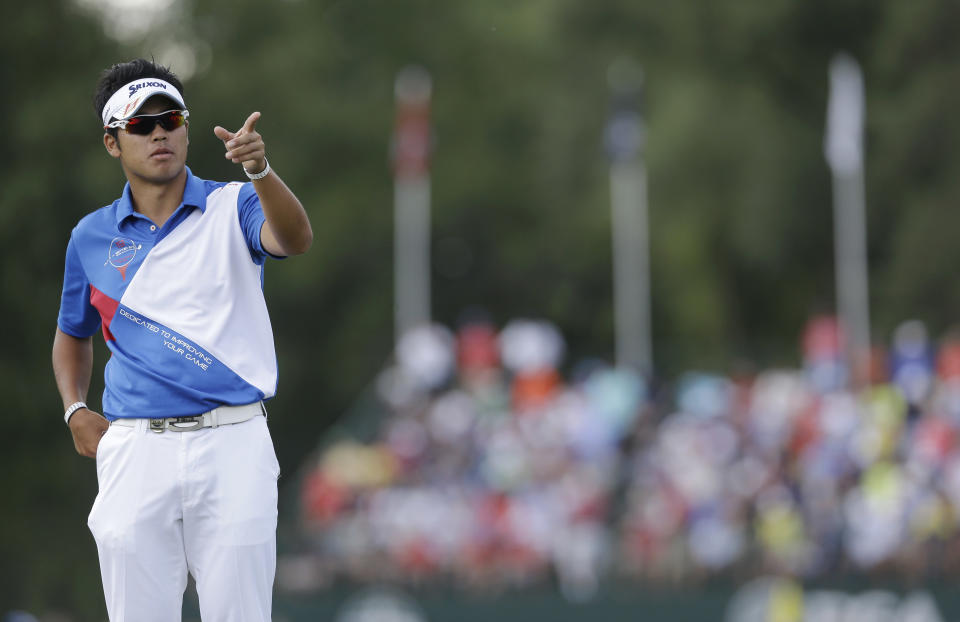Golfweek Rewind: Masters champ Hideki Matsuyama showed early promise

- Oops!Something went wrong.Please try again later.
Editor’s note: This story on recently crowned Masters champion Hideki Matsuyama originally ran in the Aug. 2, 2013, issue of Golfweek.
OAKVILLE, ONTARIO – After playing the first two rounds of the 2013 RBC Canadian Open with 21-year-old Hideki Matsuyama, Australian Greg Chalmers was so impressed with the Japanese standout’s game that he planned to jot Presidents Cup International team captain Nick Price the equivalent of a letter of recommendation.
Chalmers will be relieved to know that Price already has taken notice. In a blog posting after the U.S. Open, Price wrote of Matsuyama, “He’s not scared of the big arena. Obviously, he enjoys it, so I’ll keep a really close eye on him.”
Matsuyama, who turned professional in April, has risen to No. 33 in the Official World Golf Ranking, making him the highest-ranked Asian. [Note: He’s climbed as high as No. 2 and his Masters win lifted him back to No. 14.] He also is holding steady in eighth place in the Presidents Cup standings after posting victories at the Tsuruya Open and Diamond Cup tournaments on the Japan Golf Tour.
Moreover, he proved his game travels by becoming the first Asian to record back-to-back top-10 finishes in majors, at the recent U.S. and British opens. (He finished T-16 at the RBC Canadian Open.)
Meanwhile, Japanese sensation Ryo Ishikawa, also 21, chopped his way to a round of 80 at Glen Abbey and missed the 54-hole cut. So far, his first full season as a PGA Tour member must be characterized as a disappointment. His game seems a shell of its former self, and his world ranking, which has plummeted to No. 158, reflects it.
At home, there still is no substitute for Ishikawa. For a while, it seemed that with each tournament his celebrity grew. But fame is a force, and the public is always partial to the next big thing. Many Ishikawa supporters already have switched allegiance to the Matsuyama camp. His torrid play has brought a new kind of focus and unceasing attention on Matsuyama back home.
When asked if he has attained Ishikawa’s rock-star status, he answered, “I’m just same old me.” With a mischievous smile, he added, “I’m not as handsome as Ryo is.”
This may be the dawn of Japan’s next rivalry. What separates the two upstarts, who have known each other since junior high school, from Jumbo Ozaki and other Japanese touring pros is their recognition that the measure of greatness must come on a larger stage.
“My dream has always been to play on the PGA Tour,” Matsuyama said.
If Ishikawa versus Matsuyama is to materialize, it likely will play out here. Beginning with pitcher Hideo Nomo in 1995, Japanese sports fans have watched the best athletes flock to America. It was big news in Japan when Matsuyama and Ishikawa played nine holes together in a July 23 practice round. Yasuhiro “JJ” Tanabe, a freelance photographer who covers the Tour, said it was the equivalent of Tiger and Phil playing, “only they get along.”
Asked to assess Matsuyama’s game, Ishikawa answered with grudging appreciation. “If you watch him on the range, he’s like a regular player, but if you watch him on the golf course, he’s a different player,” Ishikawa said. “He’s a tough competitor and has a lot of confidence now.”

Hideki Matsuyama at the 2013 PGA Championship.
To the casual fan, Matsuyama may have gained recent notoriety for being assessed a one-stroke penalty for slow play during the third round of the Open Championship. To Matsuyama, the dispiriting episode is already forgotten. Chalmers, for one, deemed Matsuyama’s pace of play a non-issue. “I can think of a hundred guys out here that are worse,” he said.
Matsuyama reminded Chalmers of a more powerful version of K.J. Choi. Robert Turner, Matsuyama’s U.S.-based interpreter, worked in a similar capacity for the late Seve Ballesteros in Japan for more than 10 years and said Matsuyama has the same passion and love for the game as Ballesteros. “He can’t get enough of it,” Turner said.
To bolster his contention, Turner recounted how Matsuyama returned to Merion’s practice green after shooting a Sunday 67 at the U.S. Open, where he finished T-10. While most players packed to leave, Matsuyama hit putts for more than an hour, then hit balls as if he could improve his performance and get ahead of others through sheer repetition.
“He’s fearless too,” Turner said, “although maybe that’s being 21.”
Matsuyama sounded fearless when he was asked to name his biggest highlight this year. It could’ve been winning in his second event as a pro, or his success in the majors or perhaps the chance to see the world (he visited Niagara Falls while in Canada). Instead, Matsuyama answered, “I haven’t had it yet.”
He again spoke from the heart when asked what he’d like readers to know about him.
“I’d like to have their support and have them cheer for me,” he said. “That would mean the world to me.”

